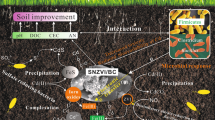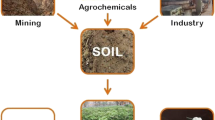Abstract
Purpose
High arsenic (As) mobility in anaerobic paddy soil due to microbial Fe- and As-reducing processes results in As accumulation into rice plants. Sulfur (S) also undergoes microbial reducing processes in the anaerobic paddy soil, while this process interacts with the Fe- and As-reducing processes, forms secondary minerals, and thus influences As mobility in paddy soil. This work was carried out to investigate the role of sulfur and sulfate-reducing bacteria (SRB) in As redox transformation and bioavailability to rice plant in an anaerobic paddy soil.
Materials and methods
Anaerobic incubation experiments with or without sulfate (SO4 2−) and SRB were carried out to monitor S and iron (Fe) dynamics and their relations to As speciation and release to soil solution. Rice cultivation in pot experiment was then carried out to check the SO4 2− amendment in bioavailability and uptake into rice plants.
Results and discussion
The inoculation of an enriched SRB community into the sterilized paddy soil increased reduction and release of As to the soil solution after flooding, showing its ability in arsenate (As(V)) as well as SO4 2− reduction to arsenite (As(III)) and sulfide (S2−), respectively. Sulfate addition (2 and 100 mM) into the anaerobic paddy soil increased the reduction of SO4 2− and ferric iron (Fe3+) and resulted to lower dissolved As in the soil solution, which limited As mobility in the paddy soil. Application of SO4 2− (100 mg kg−1) into paddy soil finally decreased the concentration of dissolved As in the soil solution by 23.5 % and also decreased As content in rice roots and iron plaque by 22.6 and 30.5 %, respectively.
Conclusions
The results revealed the important role of sulfur and the SRB activity in As speciation and mobility in anaerobic paddy soil, implying a lower As bioavailability to rice plants under sulfur-enriched anaerobic paddy soil, and an efficient way to reduce As accumulation in rice plants by sulfur fertilization in paddy soils.







Similar content being viewed by others
References
Bao P, Hu ZY, Wang XJ, Chen J, Ba YX, Hua J, Zhu CY, Zhong M, Wu CY (2012) Dechlorination of p, p′-DDTs coupled with sulfate reduction by novel sulfate-reducing bacterium Clostridium sp. BXM. Environ Pollut 162:303–310
Bostick BC, Fendorf S (2003) Arsenite sorption on troilite (FeS) and pyrite (FeS2). Geochim Cosmochim Acta 67:909–921
Bostick B, Fendorf S, Brown G (2005) In situ analysis of thioarsenite complexes in neutral to alkaline arsenic sulphide solutions. Mineral Mag 69:781–795
Burton ED, Jhonston SG, Kraal P, Bush RT, Claff S (2013) Sulfate availability drives divergent evolution of arsenic speciation during microbially mediated reductive transformation of schwertmannite. Environ Sci Technol 47:2221–2229
Burton ED, Jhonston SG, Kocar BD (2014) Arsenic mobility during flooding of contaminated soil: the effect of microbial sulfate reduction. Environ Sci Technol 48:13660–13667
Cord-Ruwisch R (1985) A quick method for the determination of dissolved and precipitated sulfides in cultures of sulfate-reducing bacteria. J Microbiol Methods 4:33–36
Couture RM, Rose J, Kumar N, Mitchell K, Wallschläger D, Cappellen PV (2013) Sorption of arsenite, arsenate, and thioarsenates to iron oxides and iron sulfides: a kinetic and spectroscopic investigation. Environ Sci Technol 47:5652–5659
Fisher JC, Wallschläger D, Planer-Friedrich B, Hollibaugh JT (2008) A new role for sulfur in arsenic cycling. Environ Sci Technol 42:81–85
Gallegos TJ, Han YS, Hayes KF (2007) Spectroscopic investigation of the uptake of arsenite from solution by synthetic mackinawite. Environ Sci Technol 41:7781–7786
Hoeft SE, Kulp TR, Stolz JF, Hollibaugh JT, Oremland RS (2004) Dissimilatory arsenate reduction with sulfide as electron donor: experiments with mono lake water and isolation of strain MLMS-1, a chemoautotrophic arsenate respirer. Appl Environ Microbiol 70:2741–2747
Hu ZY, Zhu YG, Li M, Zhang LG, Gao ZH, Smith FA (2007) Sulfur (S)-induced enhancement of iron plaque formation in the rhizosphere reduces arsenic accumulation in rice (Oryza sativa L.) seedlings. Environ Pollut 147:387–393
Huang H, Jia Y, Sun GX, Zhu YG (2012) Arsenic speciation and volatilization from flooded paddy soils amended with different organic matters. Environ Sci Technol 46:2163–2168
Jia Y, Huang H, Sun GX, Zhu YG (2012) Pathways and relative contributions to arsenic volatilization from rice plants and paddy soil. Environ Sci Technol 46:8090–8096
Jia Y, Huang H, Chen Z, Zhu YG (2014) Arsenic uptake by rice is influenced by microbe-mediated arsenic redox changes in the rhizosphere. Environ Sci Technol 48:1001–1007
Jong T, Parry DL (2003) Removal of sulfate and heavy metals by sulfate reducing bacteria in short-term bench scale upflow anaerobic packed bed reactor runs. Water Res 37:3379–3389
Jönsson J, Sherman DM (2008) Sorption of As(III) and As(V) to siderite, green rust (fougerite) and magnetite: implications for arsenic release in anoxic groundwaters. Chem Geol 255:173–181
Kirk MF, Holm TR, Park J, Jin Q, Sanford RA, Fouke BW, Bethke CM (2004) Bacterial sulfate reduction limits natural arsenic contamination in groundwater. Geology 32:953–956
Langner P, Mikutta C, Kretzchmar R (2012) Arsenic sequestration by organic sulphur in peat. Nat Geosci 5:66–73
Li G, Sun GX, Williams PN, Nunes L, Zhu YG (2011) Inorganic arsenic in Chinese food and its cancer risk. Environ Int 37:1219–1225
Liu WJ, Zhu YG, Smith FA, Smith S (2004) Do iron plaque and genotypes affect arsenate uptake and translocation by rice seedlings (Oryza sativa L.) grown in solution culture? J Exp Bot 55:1707–1713
Lovley DL, Coats JD (2000) Novel forms of anaerobic respiration of environmental relevance. Curr Opin Microbiol 3:252–256
Ma JF, Yamaji N, Mitani N, Xu XY, Su YH, McGrath SP, Zhao FJ (2008) Transporters of arsenite in rice and their role in arsenic accumulation in rice grain. Proc Natl Acad Sci U S A 105:9931–9935
Macy JM, Santini JM, Pauling BV, O’Neill AH, Sly LI (2000) Two new arsenate/sulfate-reducing bacteria: mechanisms of arsenate reduction. Arch Microbiol 173:49–57
Mondal D, Polya DA (2008) Rice is a major exposure route for arsenic in Chakdaha block, Nadia district, West Bengal, India: a probabilistic risk assessment. Appl Geochem 23:2987–2998
Newman DK, Kennedy EK, Coates JD, Ahmann D, Ellis DJ, Lovley DR, Morel FMM (1997) Dissimilatory arsenate and sulfate reduction in Desulfotomaculum auripigmentum sp. nov. Arch Microbiol 168:380–388
O’Day PA (2006) Chemistry and mineralogy of arsenic. Elements 2:77–83
O’Day PA, Vlassopoulos D, Root R, Rivera N (2004) The influence of sulfur and iron on dissolved arsenic concentrations in the shallow subsurface under changing redox conditions. Proc Natl Acad Sci U S A 101:13703–13708
Pedersen HD, Postma D, Jakobsen R (2006) Release of arsenic associated with the reduction and transformation of iron oxides. Geochim Cosmochim Acta 70:4116–4129
Poulton SW, Krom MD, Raiswell R (2004) A revised scheme for the reactivity of iron (oxyhydr) oxide minerals towards dissolved sulfide. Geochim Cosmochim Acta 68:3703–3715
Rahman MM, Ng JC, Naidu R (2009) Chronic exposure of arsenic via drinking water and its adverse health impacts on humans. Environ Geochem Health 31:189–200
Renock D, Gallegos T, Utsunomiy S, Hayes K, Ewing RC, Becker U (2009) Chemical and structural characterization of As immobilization by nanoparticles of mackinawite (FeSm). Chem Geol 68:116–125
Rittle KA, Drever JI, Colberg PJS (1995) Precipitation of arsenic during bacterial sulfate reduction. Geomicrobiol J 13:1–11
Roberts LC, Hug SJ, Dittmar J, Voegelin A, Kretzschmar R, Wehrli B, Cirpka OA, Saha GC, Ali MA, Badruzzaman ABM (2010) Arsenic release from paddy soils during monsoon flooding. Nat Geosci 3(1):53–59
Saalfield SL, Bostick BC (2009) Changes in iron, sulfur, and arsenic speciation associated with bacterial sulfate reduction in ferrihydrite-rich systems. Environ Sci Technol 43:8787–8793
Smith AH, Lingas EO, Rahman M (2000) Contamination of drinking-water by arsenic in Bangladesh: a public health emergency. Bull World Health Organ 78:1093–1103
Stroud JL, Norton GJ, Islam MR, Dasgupta T, White RP, Price AH, Meharg AA, McGrath SP, Zhao FJ (2011) The dynamics of arsenic in four paddy fields in the Bengal delta. Environ Pollut 159:947–953
Su YH, McGrath SP, Zhao FJ (2010) Rice is more efficient in arsenite uptake and translocation than wheat and barley. Plant Soil 328:27–34
Sun GX, Williams PN, Carey AM, Zhu YG, Deacon C, Raab A, Feldmann J, Islam RM, Meharg AA (2008) Inorganic arsenic in rice bran and its products are an order of magnitude higher than in bulk grain. Environ Sci Technol 42:7542–7546
Taylor GJ, Crowder A (1983) Use of the DCB technique for extraction of hydrous iron oxides from roots of wetland plants. Am J Bot 70:1254–1257
Wilkin RT, Wallschläger D, Ford RG (2003) Speciation of arsenic in sulfidic waters. Geochem Trans 4:1–7
Xu XY, McGrath SP, Meharg AA, Zhao FJ (2008) Growing rice aerobically markedly decreases arsenic accumulation. Environ Sci Technol 42:5574–5579
Zhu YG, Williams PN, Meharg AA (2008a) Exposure to inorganic arsenic from rice: a global health issue? Environ Pollut 154:169–171
Zhu YG, Sun GX, Lei M, Teng M, Liu YX, Chen NC, Wang LH, Carey AM, Deacon C, Raab A, Meharg AA, Williams PN (2008b) High percentage inorganic arsenic content of mining impacted and nonimpacted Chinese rice. Environ Sci Technol 42:5008–5013
Acknowledgments
This work is financially supported by the Natural Science Foundation of China (41401541, 41090280, 41090282).
Author information
Authors and Affiliations
Corresponding author
Additional information
Responsible editor: Yong Sik Ok
Rights and permissions
About this article
Cite this article
Jia, Y., Bao, P. & Zhu, YG. Arsenic bioavailability to rice plant in paddy soil: influence of microbial sulfate reduction. J Soils Sediments 15, 1960–1967 (2015). https://doi.org/10.1007/s11368-015-1133-3
Received:
Accepted:
Published:
Issue Date:
DOI: https://doi.org/10.1007/s11368-015-1133-3




